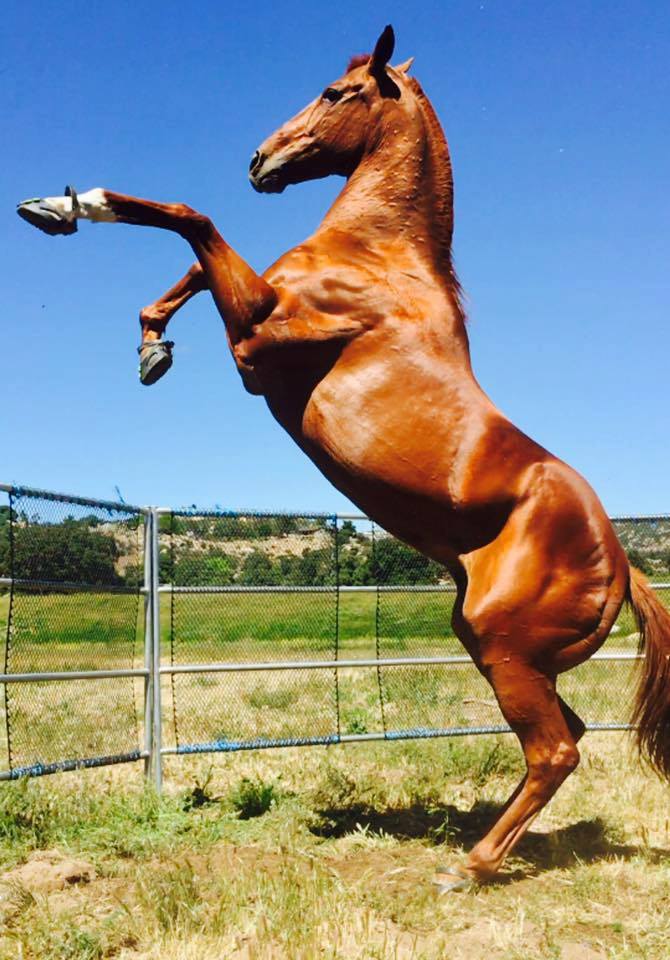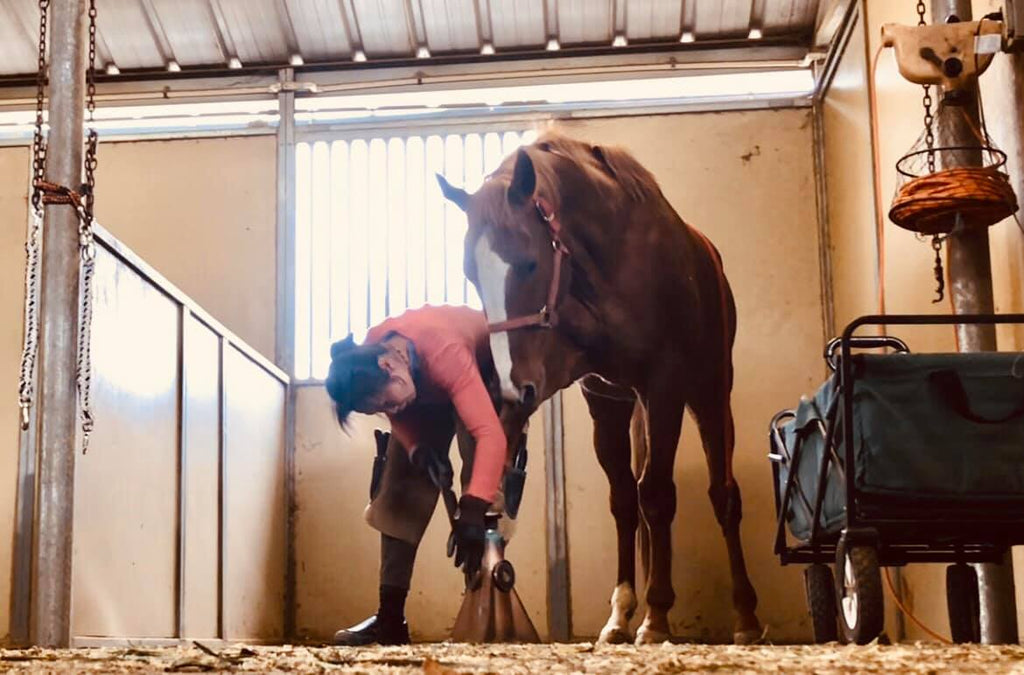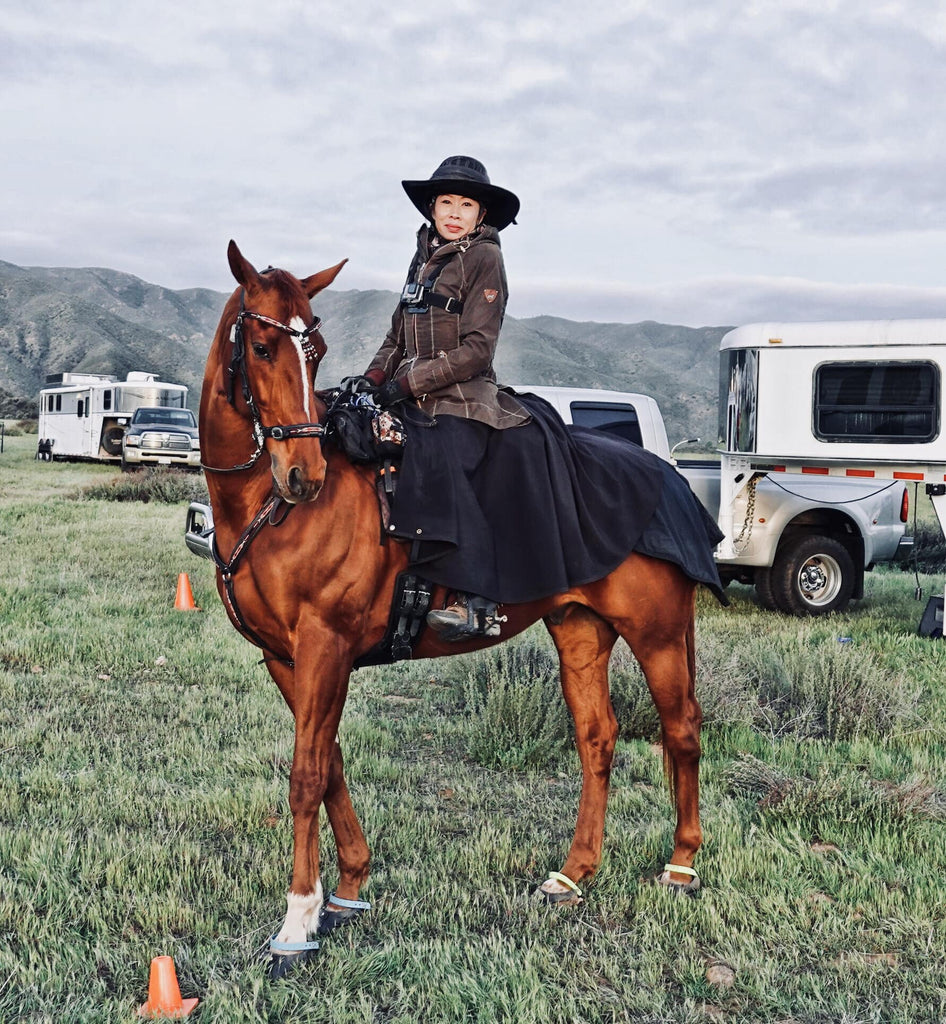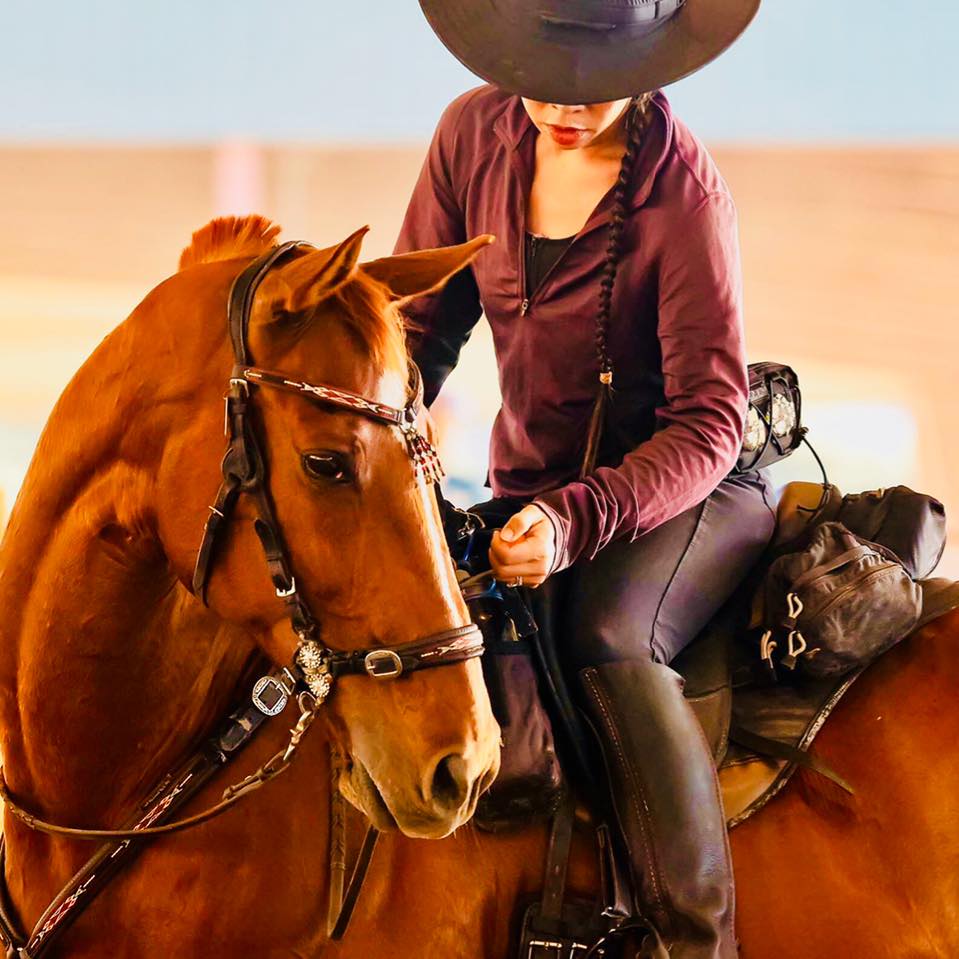
The Pros and Cons of Going Barefoot. Dawn Champion Norco, CA, United States of America
Share
Dawn Champion on the Pros & Cons of Going Barefoot
Someone was asking me about the pros and cons of going barefoot. I was surprised to see the first answer was someone saying that a horse can only go barefoot if they are not a big horse, that does not get ridden much, and cannot go at speed.
So, I felt I needed to speak up. Here is my reply; I figured I'd share it here too, since I took the time to write it all.

I have a 13 year old Off The Track Thoroughbred who was falling apart. Over the years, we've had over 7 farriers. He's had stifle, hock, and lower back issues, he would also wear out his steel shoes paper thin every 4 weeks, so I'd limit how much riding we did to save his shoes, hooves and to not exacerbate his other body issues. His hooves were getting worse and worse, they flared, had big stress rings, his heels were under-run, and more. I was always told by all the professionals, that the problem was his conformation and his breeding. TB's are known for having horrible hooves; that was because of genetics, that can't be fixed. Everything that could be done for him was being done, all we could do was manage it the best we could.
However, something just didn't sit right with me, and I looked into going barefoot with my horse. Everyone told me not to do it and basically told me I would be sentencing my horse to death if I went down that route. So, I dropped the subject.
9 months ago, I finally gathered the courage to make the barefoot leap. I bought Pete Ramey's complete DVD set and studied it obsessively. I watched and read up on everything barefoot related. I started to get a feel for my horse's hooves and see what they were really about. 9 months ago, I finally made the leap and pulled the shoes off my 17'1h, 1,300lb (590kg) OTTB for good. I've been doing all my own trims (after an initial trim by a professional barefoot trimmer). His hooves have undergone extensive remodelling and we're now working on conditioning them for rough terrain as well.

We've been using Scoot Boots in our transition. We still use them on all four hooves when galloping over extreme terrain (only on the fronts over normal terrain) and barefoot as much as he can handle to condition.
All of his body issues have disappeared. Turns out, the shoes were weakening his hooves. The 7 week trim cycle was too long; he'd get imbalanced and that would hurt his hock/stifle, which led to the lower back pain. It was all tied in to each other. He is now on a 2 week trim cycle (I check every week and just have to rasp a bit here and there to keep him balanced). Just keeping him balanced has led to tremendous benefits. Not cutting out hoof and letting him grow out his hoof naturally and as much as his body needs has helped tremendously. In fact, I now no longer have to limit our rides at all and he's never been stronger or healthier.

One of the things people said was if he wore out his steel shoes every 4 weeks, there's no way his hooves could last barefoot. That's actually not true. Steel doesn't replenish itself. It's hard and unyielding, so it actually gets shaved down paper thin. Hooves are hard, yet pliable and don't 'shave away' like steel shoes do, plus, hooves replenish themselves, and you can always put on hoof boots, such as Scoot Boots, or other products to lessen wear.

Wild horses average 15-25 miles (24km-40km) a day. We do 25-50 miles (40km-80km) a week. To many people, that is extreme, but it's still way less than what horses in the wild do and what the hoof is capable of handling. With steel shoes, we were limited by it's finite nature. Hooves are extremely adaptable, they grow and change depending on what the horse needs, and they are extremely responsive and reactive. Unlike steel, the more you use them, the stronger they get, and the faster the hooves grow. The horse's body knows what it needs to overcome conformation issues and it adapts accordingly.
I aim to stop interfering and blocking nature's way and instead, try to better understand, support and help it along. We have never been happier going this route. The only con is that there is the biggest learning curve (I'm still learning and there's so much contradicting advice out there) and very little support. The pros are:
- I'm saving tons of money
- My horse is in the best health
- There are no more hoof flares or stress rings
- His toes are being brought back
- His heels are improving from being under-run and he's now developing good heels
- There are no longer any limits to how hard or long we ride
- I'm now more educated on whole horse health... more knowledge is always good
Barefoot Myths Busted:
1. Thoroughbreds can't go barefoot, good hooves have been bred out of them.
2. Large horses can't go barefoot.
Truth: Lasair is 17.1h and 1,300lbs (590kg). I know drafts that are barefoot too; many of the Disneyland Carriage horses are barefoot.3. You can only go barefoot if you don't ride a lot.
4. You can't ride at speed.
5. You can't ride over rocks.
Truth: There are barefoot hooves out there called 'rock crunchers'. They can handle any rocks without any issue. Unfortunately, not all horses will get to this point, but that is probably due more to improper conditioning and a pinch of genetics. As we become more knowledgeable on how to best support and condition barefoot hooves, they may become more common.6. Hooves are weaker than steel shoes.
Truth: Absolutely not. Only on the hardness scale, but hard and unyielding can be a detriment, not a strength. The hoof is pliable, adaptable and mouldable, it is extremely responsive and reactive to its conditions and the forces applied to it. The more you use the hoof, the faster it grows. The harder you use the hoof, the stronger it gets. Nature is amazing that way. Machines are built with a finite number of miles on them, they can only break down. Nature and life is the complete opposite.7. It's too much work.
Truth: Actually, it's not when you stay on top of it. Farriers come out every 6-12 weeks, so you see them take a lot of hoof off every time they visit. If you stay on top of it and do a little barefoot trimming every week or two, it's very manageable. However, the transition period is challenging, but once it levels out, the hoof finds a natural balance, then there's very little you need to do, just help the hoof stay balanced by doing regular barefoot trims. Have you ever noticed how hair has a limit on how long it grows? If you shave it, it grows back... sometimes thicker and faster. But if you leave it alone at the length it wants to be, it just stays at that length? Now, hooves are different, they can definitely get horrendously overgrown, but my point is, I think most shod hooves are actually cut short. Say a hoof should be 5" (12.5cm) tall. The farrier cuts it down to 4" (10cm) and puts a 1" (2.5cm) steel shoe on. That 4" (10cm) hoof is too short to be barefoot, that's why it hurts if the horse hits rocks and why there's a 'Barefoot Transition Period'. Once you have an established a barefoot hoof, you're not cutting out that inch all the time, you're just filing it and keeping it nice and balanced at 5" (12.5cm). These numbers are just thrown in to make my point, they are not real numbers.8. It's too much money.
Truth: Pete Ramey's Complete DVD and Book Set is $425.00. Hoof Jack (optional) is $189.00. Nippers, Rasp, Hoof Knives, etc; let's say $400.00. Now you figure, how much does your schooling cost? I put myself through college and had to bust my butt. Very little of that schooling applies to real life and I don't use much of that knowledge compared to the $425.00 of pure gold data from Pete Ramey's Set. Most other equipment and tools are a one time purchase and won't really need to be replaced if you take care of it. It's really only the $30.00 rasp that needs to be replaced when it gets dull. My rasp is still going strong after 9 months of trims on 1 horse. I think professional farriers and barefoot trimmers go through rasps like one a day or something crazy like that, but they are pros and do lots and lots of trimming. What is the price for a healthier, happier horse, a fuller and deeper understanding of proper equine husbandry, and no more having to gamble on a farrier or barefoot trimmer? Every one is different, but for me, that's priceless.9. My horse is horrible/dangerous for the farrier, there's no way I can handle him!
Truth: This is actually Lasair and me. Lasair is notoriously difficult for farriers and has hurt several throughout his life. This is something we've struggled with over the years and my last farrier is a saint for sticking with us and being so patient to help me. Well, it turns out, Lasair was not being an asshole because he was evil, he was trying to tell us something; it hurt, he was tender, he didn't like it. For all these years, he was trying to communicate and we weren't hearing it, we just thought he was a bad horse. I no longer have any fights with him about trims and he is perfect! I can sit or kneel down and he'll just hold his hoof for me. No more fighting. If I start getting a little too obsessive and start digging at his hoof a bit, he gets defensive, again, and will start trying to pull his hoof back. I recognise this now and reassure him that I'm not going to go too deep, trust me, then he relaxes and lets me have his hoof again without fight. Just saying.
10. Going barefoot on my 13 year old horse, who's been shod all his life and has had multiple hoof issues is going to be hard.
Truth: This is us again, and this one is true. We had very little support, which makes us all the more grateful for the support we did have! There are tons of conflicting advice out there, even within the realm of barefoot trims. Many professionals can't even agree on what the truth is. Many pros have been operating on misinformation. Many pros are doing it wrong. Many pros are still learning; these are the good ones. The truth is, science does not exactly know how to best manage the barefoot hoof. Much of this is because steel shoes have been the acceptable practice for so long. But remember, even farriers are taught that hooves are not supposed to be shod 24/7, all year long. They are trained that hooves are meant to be left barefoot for several months (2-6 months) each year 'to let them recover from the effects of being shod'. Most people just don't do that, meaning, issues start to arise. Yes, it's hard. If you're lucky, you'll find a good barefoot trimmer who can do the trims for you. If not, then you might have to learn how to do it yourself. There's a steep learning curve and there is SOOO much to learn about hooves! If your horse has bad hooves like Lasair did, then they will go through a HUGE barefoot transition phase, where the hoof has to recover, remodel, and then strengthen. This will take between 4 months and 2 years depending on the hoof. You may have to redesign your entire feeding schedule and protocols, since a proper diet is paramount to good hooves. There are things like hoof boots, such as Scoot Boots, and Hoof Armour that can help your horse through the barefoot transition period. Finding the right hoof boot for your horse can be a whole adventure and ordeal in itself. In the barefoot world, not enough is talked about when it comes to the barefoot transition phase, most is focused on the final product. So, people will tell you what the hoof *should* look like, but not what happens when you're in the barefoot transition period for a year and how the hoof absolutely does NOT look like that yet; it looks ugly, it's developing strange callouses and extra growths because it's in a defensive phase.
We were lucky because even though it was 'hard' and there was a steep learning curve… and I've made mistakes and will definitely make more as I learn… Lasair was never lamed during this whole transition. He has been owie for a day or two, but he's had that after getting new shoes by professional farriers too. His hooves have never been better. Issues like under-run heels, flare, chronic seedy toes and huge stress rings have all disappeared! Stifle, hock and lower back pain issues have gone away. He will continue to benefit as I learn more and get better. But it's good to know that there is a pretty wide safety margin. Most hooves (barefoot or shod) have some kind of pathology affecting them, yet the horse is perfectly sound. The difference will be how long can their hoof and body can keep compensating. There is a big safety margin and that has been a pro and a con. The pro is that if you really, truly, try your best and take the necessary steps, you can do it. You can provide better care than a professional that doesn't see or care. The con is that many methods are believed to be the right way because, empirically, they work. This is difficult to ascertain because of the huge safety margin, meaning, you won't see the damaging effects until many years down the line. How do we find the right answer then?
Here's a thought, instead of assuming that the hoof needs us to intervene and take over, what about trusting the hoof more? Maybe there is a reason the hoof grows a hoof wall, sole and bar. Maybe the reason is not for us to go chopping it all away the minute it grows in. What happens if, instead of being all chop happy, we sit back and observe. See, and try to understand what the hoof is trying to tell us. The hoof may throw out ugly callouses that does not fit the perfect hoof model, so try to understand what those callouses are trying to protect and help it do it (hint: chopping it away the moment you see it, is not helping). Take a step back and listen to what the hoof is saying. Give it time. Don't assume you know better than nature.
11. Not all hooves can go barefoot.
Truth: I don't know enough to say if this is true or not. My guess is that it is true, for the mere fact that nothing is ever 100%. There are hoof and conformation issues that could benefit from steel shoes. Humans are not complete idiots and some of their inventions do actually work, it's just when we overly rely on them to the point that they totally replace nature, is when we get into trouble. Any extreme is never good. Many times, it's not the tool that is lacking, it's the skill and knowledge level of the hand holding the tool that is lacking or is at fault. No two farrier or barefoot trimmer is the same. One farrier could totally lame a horse, while another one will do perfect trims. Farriers are not evil. Steel shoes are not evil. If your horse needs steel shoes, don't eliminate that from your tool box. Just make sure you have the knowledge to make the best decision. I see shod horses that could do better barefoot. I've seen barefoot horses that could do better with the attention of a skilled farrier.
There is no magic formula that works for every horse. Each horse is an individual and their hooves reflect as much. Knowing all the factors, learning as much as you can from as many methods as possible, and having as many tools in your tool box as possible, is how you provide the best custom tailored care for your unique horse.
Dawn Champion - Norco, CA, United States of America
Building a Supportive Barefoot Community
The team at Scoot Boot believe passionately in the barefoot horse and strive to build a supportive community of barefoot horse lovers.
Find more information about using Scoot Boots here.

